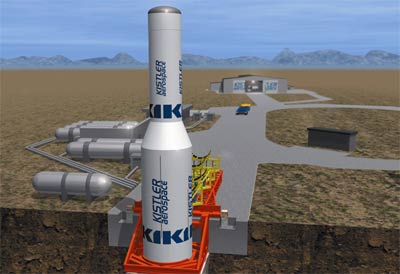Kistler, rising from the ashesby Taylor Dinerman
|
| What wrecked the original Kistler was a lack of money, not a lack of talent or problems with the design. |
The modified NK-33s are now referred to by Aerojet as the AJ-26. They now have a full set of US-made electronic controllers, ignition systems, control valves, and thrust vector controls. In their new form, they have been thoroughly tested and are as ready for operations as any previous type of rocket engine. The vehicle itself stands more than 37 meters tall and will weigh 382,300 kilograms according to company documents. When operational it will be able to carry 3,200 kg of payload into orbit and bring 900 kg back down to Earth.
What wrecked the original Kistler was a lack of money, not a lack of talent or problems with the design. As is so often the case they appear to have used the US bankruptcy laws to reorganize or repair what was a broken financial structure. The company emerged from Chapter 11 in March 2005 but it was not until earlier this year when they teamed up with Rocketplane that they seemed to have made a full recovery. The two companies have not yet fully merged in the legal sense, but for all practical purposes they are now one.
The Kistler design was originally created with the US government as a primary customer in mind. Even at the height of the speculation over the market for launching “Little LEO” satellite constellations Kistler was always looking to make a deal with NASA. In fact they first received a contract to study alternative access to the ISS in 2000, and they did get some support form the now-defunct Space Launch Initiative. Their long-standing relationship with the space agency likely helped them to win their share of the COTS award.
Now that they have won the chance to develop an ISS resupply business, they need a good dose of private capital on top of the $207 million they expect to get from the US government. This may be more difficult, as smart investors know that others have been hurt in such efforts in the past. Even though the potential rewards for the company that develops a successful RLV and proves it can drastically cut the cost of access to orbit will be substantial, skepticism amongst investors is very high. Kistler could, if successful, dominate the small to medium payload market in the 2010–2020 decade, a market that would expand considerably if the per kilogram to orbit costs were cut by more than 50%.
A few years ago the secretary of the Air Force and the head of NASA both announced that they did not believe that the technology existed for a successful RLV. They claimed that what was needed was a revolution comparable to the one that happened when jet engines were introduced. Since then there has not been any new technology that could, in fact, dramatically change the situation. One possibility is that the men who decided that the technology was not ready were responding their own institutional problems with efforts such as NASA’s SLI and X-33 and the Defense Department’s inability to get its various military spaceplane initiatives funded.
In spite of that judgment, the RLV industry has been moving forward funded both by small government contracts and by a few angel investors. SpaceShipOne proved that suborbital vehicles can be built for relatively modest sums. Other potential RLVs are being built, but none is as ambitious as the Kistler K-1. At least one report claims that they are hoping to have their first flight from their Australian base in late 2008. Company insiders, though, are more cautious and don’t want to make promises they cannot keep.
| For NASA and for Kistler’s new investors this project is a big gamble. However it may pay off in a huge way. If Kistler can truly provide ultra-low-cost access to the ISS, it will revolutionize the space industry. |
The greatest problem that this company may face is neither technological nor financial but instead their relations with the established aerospace industry. For an entrepreneurial company they are subcontracting an awful lot of their effort to organizations such as Lockheed Martin and Alenia Spazio. The concern is that these companies will not only incorporate their large overhead costs in what they charge for their products and services, but, since they have their own launch vehicle programs, may not have the best interests of Kistler at heart. Management will have to be very careful and will have to be technologically and legally very sophisticated when dealing with these major firms.
For NASA and for Kistler’s new investors this project is a big gamble. However it may pay off in a huge way. If Kistler can truly provide ultra-low-cost access to the ISS, it will revolutionize the space industry and could have, for up to a decade, something like a monopoly on the market. They may be able to man-rate the K-1 and begin providing large numbers of space tourists with affordable trips to space hotels or even to “space yacht clubs”.
Even more than Elon Musk’s SpaceX, the success of Rocketplane Kistler could change the whole nature of the space industry. However, extraordinary potential equals extraordinary challenges and to make the K-1 work requires surmounting difficulties that have stumped the some of the best and brightest scientists and engineers. NASA is giving them a chance, and COTS gives them a wide choice in the way they go about sending cargo to the station. Whether or not they succeed is largely up to them.
